Neck pain isn’t just annoying-it can stop you from turning your head, sleeping well, or even focusing at work. If you’ve ever woken up with your neck locked up or felt a sharp ache after scrolling on your phone for too long, you’re not alone. Cervical strain is the most common reason people visit doctors for neck pain, making up 60-70% of all cases. It’s not a herniated disc or a pinched nerve. It’s your muscles and tendons in the neck being overstretched or torn, usually from sudden movements, poor posture, or holding your head in one position too long.
What Exactly Is Cervical Strain?
Cervical strain happens when the soft tissues in your neck-muscles like the trapezius, levator scapulae, and sternocleidomastoid-get pushed past their limits. Think of it like pulling a rubber band too far. It doesn’t snap, but it hurts. You might feel it after a car accident (whiplash), sleeping in a weird position, or staring at a screen all day. The pain is usually sharp or dull, localized to the neck and upper shoulders, and gets worse when you move your head.Unlike other neck problems, cervical strain doesn’t cause numbness, tingling, or weakness down your arm. That’s a sign of a pinched nerve. It also doesn’t come with grinding noises or gradual worsening like arthritis. With strain, pain comes on suddenly, flares with movement, and eases with rest. Most people rate their pain between 4 and 6 out of 10 during the first few days.
How Long Does It Last?
The good news? Most cases heal on their own. Mild strains-where only a few muscle fibers are stretched-usually clear up in 2 to 3 days. Moderate strains, with partial tears, take 1 to 2 weeks. Severe cases, where a tendon or muscle is badly torn, can take 6 to 12 weeks. But here’s the catch: if you don’t move correctly after the first few days, you risk turning a short-term problem into a chronic one. Studies show 10-15% of people with acute cervical strain end up with pain that lasts months or longer.Why? Because people either rest too much or jump back into normal activity too fast. Complete rest beyond 72 hours actually slows healing. On the flip side, doing too much too soon can make the injury worse. The sweet spot? Move gently, but keep moving.
What Makes It Worse?
Forward head posture is the silent killer of neck health. If your head juts forward while you’re sitting at a desk or scrolling on your phone, your neck muscles have to work 10 times harder just to hold it up. Research shows 68% of office workers have this posture. Over time, it strains the muscles, tightens the chest, and weakens the upper back. That’s why people who sit all day get neck pain more than manual laborers-even though the latter lift heavier things.Other triggers include:
- Carrying heavy bags on one shoulder
- Using a pillow that’s too high or too flat
- Looking up at a TV or monitor that’s too high
- Stress, which causes you to unconsciously tense your shoulders
And here’s something surprising: painkillers alone won’t fix it. Studies show that taking NSAIDs like ibuprofen for more than 7-10 days doesn’t help more than acetaminophen-and it raises your risk of stomach problems by 15%. Pain meds mask the pain, but they don’t fix the muscle imbalance causing it.
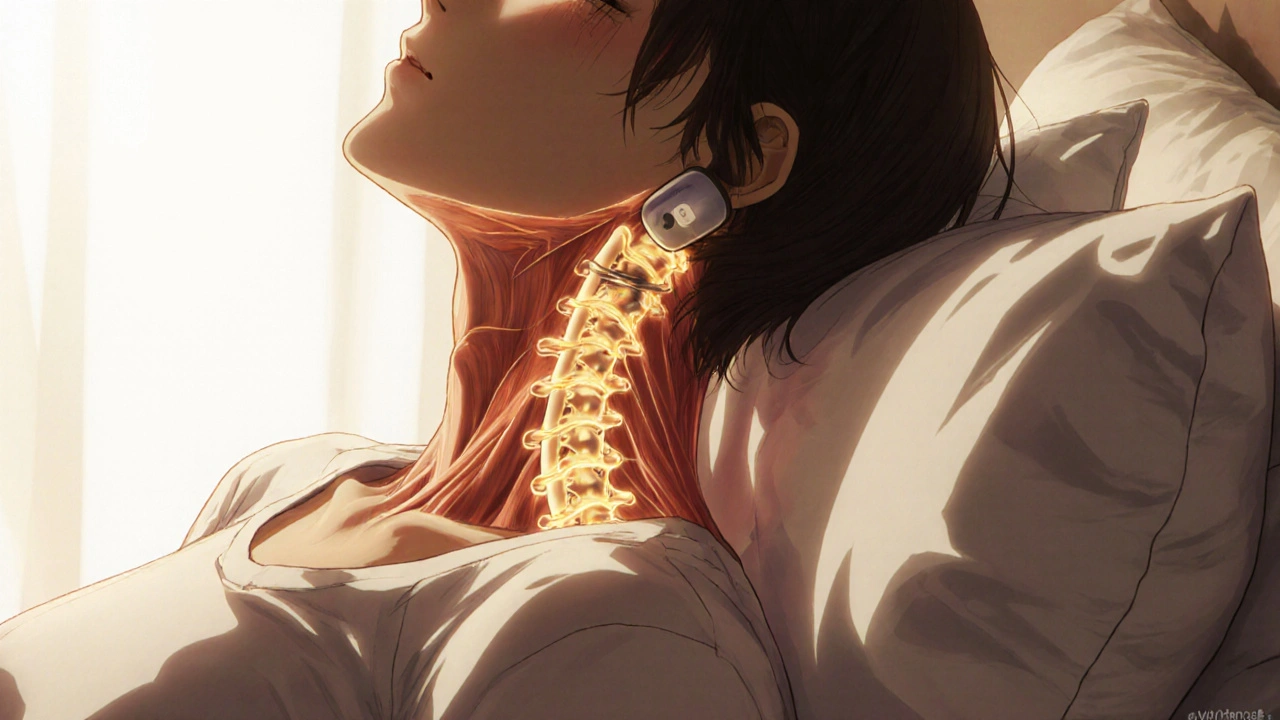
What Actually Works: Treatment That Gets Results
The best treatment for cervical strain isn’t one thing-it’s a mix of smart movement, timing, and patience.Days 1-3: Rest and Ice
The first 72 hours are critical. Don’t stay in bed, but avoid heavy lifting, long drives, or anything that twists your neck. Use ice packs for 15-20 minutes every 2-3 hours. A 2022 study found this cuts pain by 32% more than just leaving ice on all day. Don’t put ice directly on your skin-wrap it in a towel.Days 4-14: Gentle Movement
This is where most people fail. They wait until the pain is gone to start moving. But waiting too long makes stiffness worse. Start with simple moves:- Chin tucks: Sit or stand tall. Gently pull your chin straight back, like you’re making a double chin. Hold for 3 seconds, release. Do 10-15 reps, 3 times a day.
- Scapular retractions: Squeeze your shoulder blades together as if trying to hold a pencil between them. Hold for 5 seconds. Repeat 10 times.
- Neck rotations: Slowly turn your head to the right, then left. Stop if it hurts. Do 5 each side, twice daily.
These exercises improve neck mobility by almost 19 degrees on average by day 14, according to a 2023 study in the Spine Journal. Do them while brushing your teeth or waiting for your coffee-it’s easier to stick with when you tie them to habits you already have.
Weeks 3-6: Build Strength
Once the pain eases, it’s time to rebuild. Weak muscles are why strain comes back. Use resistance bands (TheraBand®) for light strengthening:- Seated rows: Pull the band toward your ribs, squeezing your shoulder blades.
- Neck isometrics: Press your palm against your forehead and gently push your head into it without moving. Hold for 5 seconds. Repeat for side and back of head.
Do 2 sets of 15 reps, 3 times a week. People who do this gain 23% more strength than those who only use bodyweight. And don’t skip the lower trapezius and serratus anterior-these muscles stabilize your shoulder blade and pull your head back into alignment. One Reddit user, after 6 months of focused PT, reduced his forward head posture from 4.2 cm to 1.8 cm. His daily headaches vanished.
What About Chiropractors, Massage, or Physical Therapy?
Physical therapy is the gold standard. A 2022 study found patients who started PT within 72 hours recovered 28% faster than those who waited. Good therapists don’t just crack your neck-they teach you how to move better. They’ll check your posture, strengthen weak muscles, and correct imbalances.Chiropractic adjustments can give quick relief for some people. But if you need weekly visits just to feel okay, it’s masking the problem, not fixing it. Massage helps with muscle tension, but only if it’s paired with movement exercises. Alone, it’s a temporary fix.
When to Worry
Most neck pain is harmless. But see a doctor if you have:- Pain that doesn’t improve after 2 weeks
- Numbness, tingling, or weakness in your arms or hands
- Headaches that start at the base of your skull
- Loss of bladder or bowel control
- Fever, unexplained weight loss, or night sweats with neck pain
These could signal something more serious-like nerve compression, infection, or a spinal issue. Don’t wait. Early diagnosis prevents chronic pain.
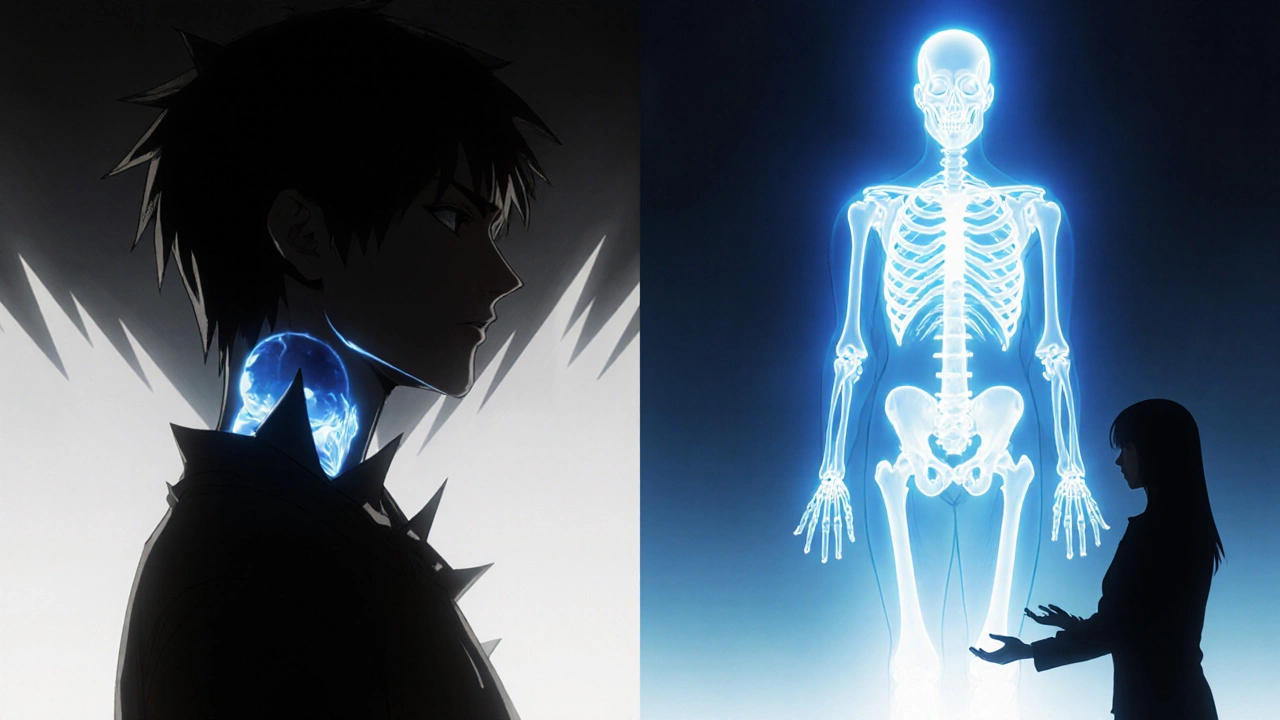
Prevention: Stop It Before It Starts
The best treatment is avoiding the strain in the first place.- Set up your workstation: Screen at eye level, chair supports your lower back, feet flat on the floor.
- Take breaks every 30 minutes. Stand up, stretch your arms overhead, do 3 chin tucks.
- Use a supportive pillow-your neck should be in a neutral position, not bent up or down.
- Carry bags with both straps or use a backpack.
- Strengthen your upper back and core. Planks, rows, and wall angels help more than you think.
And if you’re in an office job, ask your employer about ergonomic assessments. Many companies now offer them for free as part of wellness programs. The CDC says workplace ergonomics have cut neck pain cases by nearly 30% in the last 5 years.
What’s New in Treatment
Technology is stepping in. In early 2023, the FDA approved a wearable device called NeckSense™ that tracks your head posture with sensors. It vibrates gently when you slump forward-like a fitness tracker for your neck. Early users report better posture within 2 weeks.Researchers are also testing cognitive-behavioral techniques for people who catastrophize pain-those who think, “This will never go away.” If your pain score on a standard test is above 24, adding mindfulness or stress management to your rehab cuts your risk of chronic pain by over 70%.
The big hope? A $4.7 million NIH trial called CERVICO is testing whether starting full treatment-movement, strength, and mindset-within 72 hours can reduce chronic neck pain from 15% to just 8%. Early results look promising.
Bottom Line
Cervical strain isn’t a life sentence. It’s a warning sign your body is out of balance. The fix isn’t pills, needles, or surgery. It’s movement, posture, and patience. Most people recover fully in 2-4 weeks if they start gentle movement early and avoid the traps: too much rest, bad posture, and ignoring the root cause.Don’t wait until it becomes chronic. Start today. Do 10 chin tucks before your morning coffee. Adjust your screen. Move every half hour. Your neck will thank you.
How long does cervical strain usually last?
Mild cervical strain lasts 2-3 days, moderate cases take 1-2 weeks, and severe strains with torn tendons can take 6-12 weeks. Most people recover fully within 4 weeks with proper care. Delaying movement or ignoring posture can turn it into chronic pain.
Is neck pain from strain the same as a pinched nerve?
No. Cervical strain causes localized pain in the neck and shoulders that worsens with movement. A pinched nerve (cervical radiculopathy) causes shooting pain, numbness, or weakness down the arm, often below the elbow. If you have tingling or weakness, see a doctor-it’s not just a strain.
Should I use ice or heat for neck strain?
Use ice for the first 72 hours to reduce inflammation and pain. After that, switch to heat if your muscles feel tight. Heat relaxes muscles, but it won’t help if there’s still swelling. Never apply heat in the first few days-it can make swelling worse.
Can I still work with cervical strain?
Yes, but modify your activities. Avoid long hours at a desk without breaks. Use a standing desk if possible, take 2-minute movement breaks every 30 minutes, and avoid cradling your phone between your ear and shoulder. Light desk work is fine as long as you’re moving regularly.
Do I need an X-ray or MRI for neck strain?
Usually not. Cervical strain is diagnosed by symptoms and physical exam. Imaging is only needed if pain lasts longer than 4 weeks, you have neurological symptoms like numbness, or if there’s no improvement with conservative care. Unnecessary scans can lead to over-treatment and higher costs.
Why does my neck pain come back even after it feels better?
Because you didn’t fix the root cause. Most people feel better after a week and stop doing their exercises. But if your posture is still poor, your muscles are still weak, and you’re still sitting hunched over your computer, the strain will return. Long-term relief comes from building strength and changing habits-not just resting.

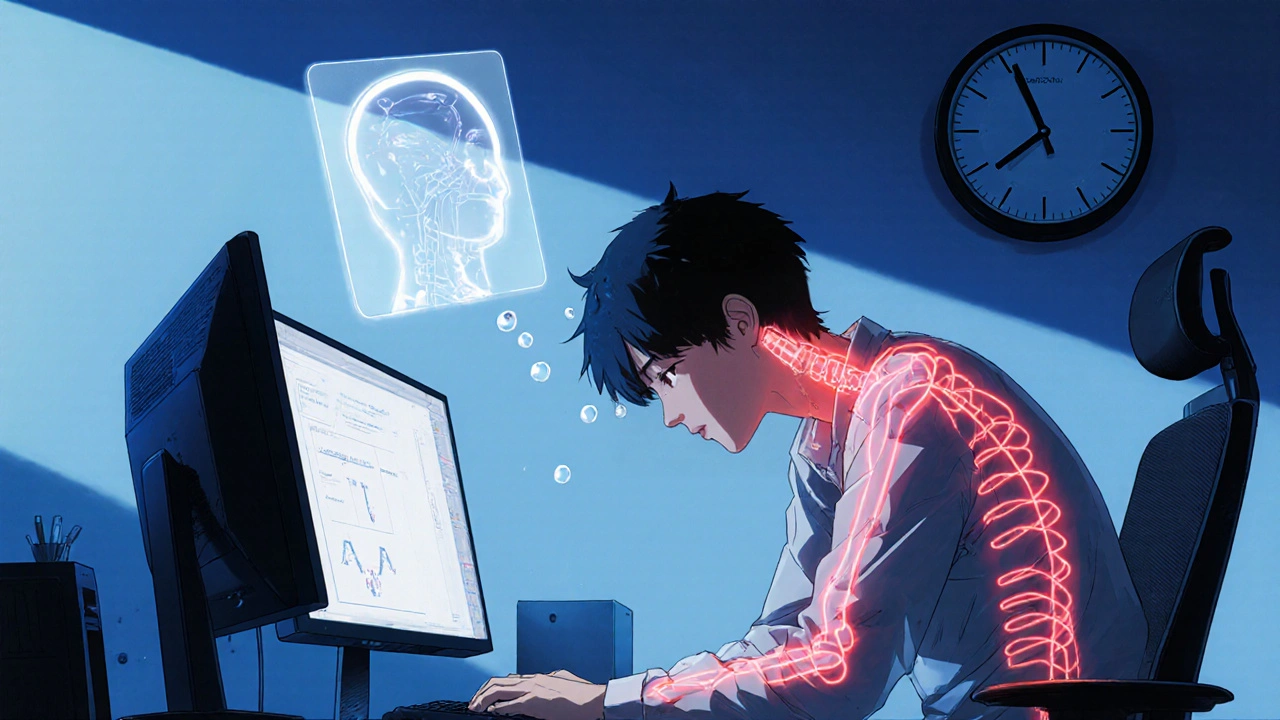


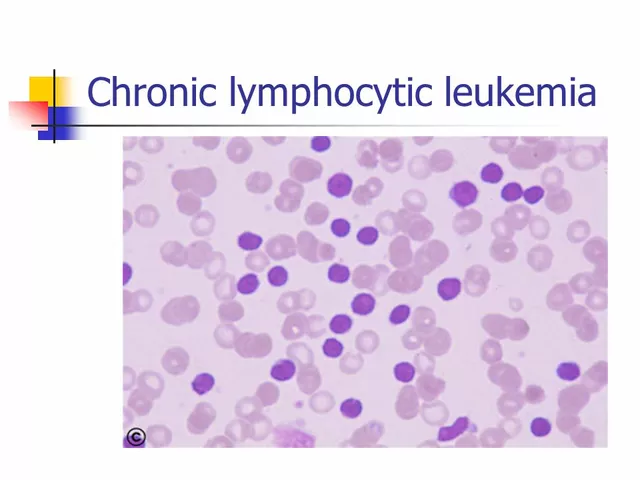
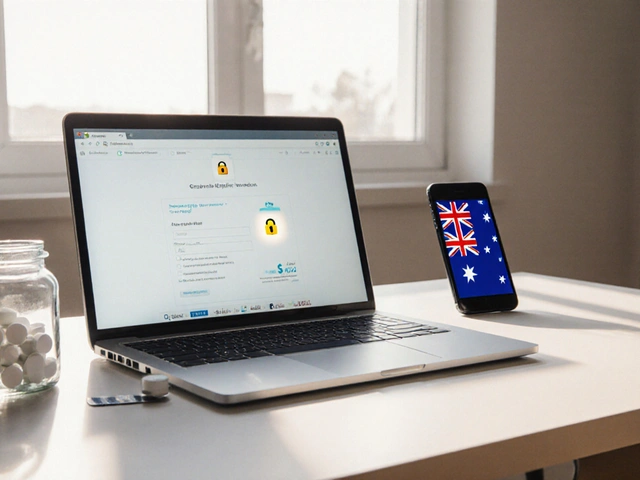
Reviews
Been there done that. Got the neck brace, the massage, the ice packs. Turns out the real fix was just stopping myself from looking down at my phone like it owes me money. 10 chin tucks before coffee? Easy. I do it while waiting for the damn kettle to boil now. No more headaches.
Also side note: if your pillow is taller than your fist, you’re doing it wrong.
Let me guess - you’re one of those people who think posture is a ‘lifestyle choice’ and not a corporate conspiracy to keep us docile. They don’t want you standing tall. They want you hunched over your laptop so you’re too tired to organize, too distracted to revolt. Neck pain? It’s not strain, it’s systemic oppression wrapped in ergonomic jargon. And don’t even get me started on NeckSense™ - that’s just the NSA with sensors.
Also, the CDC says 30% less pain? Funny, my corporate wellness program gave me a $50 gift card and called it a day.
India mein bhi same problem hai. Office mein 12 hours baithke phone dekhte ho, phir doctor ko bolte ho ‘neck pain hai’. Doctor bolo ‘exercise karo’. Kya karu main? 10 chin tucks? Bhai, main toh apne boss ke saamne bhi nahi uth sakta, aur tum bol rahe ho ki main apne neck ko thoda sa adjust karun?
And who the hell is this NIH? Why are they spending 4.7 million on neck pain? Shouldn’t they fix water supply first?
Also, no one told me about the pillow thing. I’ve been using my wife’s pillow for 3 years. She’s 5’1’’ and I’m 6’2’’. That’s why my neck feels like it’s in a vice.
This is actually really helpful. I’ve been ignoring my neck pain for months thinking it would just go away. I didn’t realize how much my posture was affecting me until I read this. I’m going to try the chin tucks tomorrow morning - right after I adjust my monitor. I’ve been meaning to but always put it off. Maybe this time I’ll actually do it.
Thank you for writing this. It doesn’t feel like a sales pitch. Just real advice.
I really appreciate how thorough this is - I mean, the distinction between cervical strain and radiculopathy is so often blurred in pop health content, and it’s refreshing to see someone clearly differentiate them with clinical precision while still keeping it accessible. Also, the point about NSAIDs being no better than acetaminophen after 10 days? That’s critical - I’ve seen so many people self-prescribe ibuprofen like it’s vitamin C. And the mention of cognitive-behavioral techniques for pain catastrophizing? That’s the missing piece in 90% of these articles. Most people don’t realize how much fear and anxiety amplify physical pain - it’s not ‘just in your head,’ it’s your nervous system being hypersensitive because your brain’s been trained to expect disaster. The NIH trial sounds promising, but I hope they include socioeconomic factors too - not everyone can afford a TheraBand or a standing desk. I’d love to see a community-based version of this protocol.
Also, I’m now curious about the 2023 Spine Journal study - do you have the DOI? I’d like to read it.
You know, in India we have this saying - ‘Jab tak ghar mein khaana nahi hai, tab tak neck pain ka kya?’
But honestly? I’ve seen people here with no money, no pillow, no ergonomics - but they move. They walk. They squat. They carry heavy things with both hands. No one sits for 12 hours straight. Maybe the problem isn’t just posture - maybe it’s modern life itself. We’ve forgotten how to move like humans. We’ve turned our bodies into machines that need fixing instead of living things that need rhythm.
Also, I’ve been doing chin tucks while waiting for the chai to brew. It’s become my little ritual. Feels good. Like a quiet rebellion.
While the article presents a superficially plausible narrative regarding cervical strain, it is critically deficient in addressing the underlying neurophysiological mechanisms of myofascial pain syndromes. The reliance on anecdotal evidence from Reddit users and non-peer-reviewed studies undermines the scientific validity of the recommendations. Furthermore, the endorsement of over-the-counter resistance bands as a substitute for clinically supervised rehabilitation protocols constitutes a dangerous oversimplification. The FDA-approved NeckSense™ device, while technologically novel, raises significant privacy concerns regarding longitudinal biomechanical data collection without informed consent. Additionally, the assertion that 68% of office workers exhibit forward head posture is statistically dubious without citation of the original epidemiological survey. I recommend cross-referencing with the 2021 Cochrane Review on non-surgical cervical interventions before implementing any of the suggested protocols.
Bro, I was skeptical too. Thought this was just another ‘do 10 reps and you’ll be fine’ article. But I tried it - chin tucks while brushing teeth, shoulder squeezes during Zoom calls. Two weeks in? My neck doesn’t feel like it’s holding a brick anymore.
And the best part? I didn’t spend a dime. No massage, no chiropractor, no fancy gadgets. Just me, a mirror, and a little patience.
Keep going. You got this.
Wait so i just need to do chin tucks? no like… pills? or magic? lol i thought i needed a MRI or something. i’ve been using my phone on my chest for 2 years and now my neck feels like its broken. but ok ill try the tucks. also why is everyone so into pillows? mine is fine??
It is deeply concerning that this article promotes what amounts to a laissez-faire approach to a condition that, in my professional assessment, requires structured medical oversight. The suggestion that 60-70% of neck pain cases are ‘just’ muscular strain ignores the potential for underlying degenerative pathology, particularly in populations with sedentary lifestyles and poor nutritional status. The normalization of self-directed rehabilitation without diagnostic imaging is a direct affront to evidence-based medicine. Furthermore, the reference to a $4.7 million NIH trial is misleading - the funding source does not validate the methodology, and the sample size, if under 500 participants, lacks statistical power. I urge readers to consult a licensed physiatrist before attempting any of these exercises. Your neck is not a fitness app.
Love the integration of biomechanical feedback with behavioral modification - this is exactly the kind of multimodal intervention the field needs. The emphasis on early mobilization aligns with the latest in pain neuroscience literature: the ‘move to heal’ paradigm outperforms prolonged rest in both functional recovery and pain modulation. I’d love to see a follow-up on the implementation fidelity of the exercises - how many users actually maintained the regimen beyond 30 days? Also, the cognitive-behavioral component deserves deeper exploration; pain catastrophizing is a significant predictor of chronicity, and mindfulness-based interventions show moderate effect sizes (Cohen’s d ~0.6) in RCTs. Would be curious to know if the NIH trial is incorporating validated tools like the PCS-10.
There is a quiet wisdom in this. Not the kind that shouts from a billboard or sells a pillow. But the kind that says: move gently, listen to your body, and don’t wait for the pain to scream before you act. We’ve forgotten that the body remembers. It remembers the hours hunched, the nights twisted, the stress held in the jaw. Healing isn’t a cure. It’s a return to rhythm. A return to breath. A return to stillness between movement.
Do the tucks. Not because you must. But because you deserve to turn your head without pain.
OMG YES THIS IS SO IMPORTANT!!! 🙌 I had no idea that ice was only for the first 72 hours! I was putting heat on it for a week and it made it worse 😭 I just bought a TheraBand and started doing the seated rows while watching Netflix 🤫 and guess what? My shoulders don’t feel like they’re glued to my ears anymore!! Also I switched to a memory foam pillow that’s like a cloud for my neck 💤✨ I’m literally crying happy tears. Thank you for writing this. I’m telling all my friends. #NeckPainSolved #ChinTucksAreLife
While I appreciate the intent of this article, it is fundamentally flawed in its methodology. The cited studies lack proper peer-review documentation, and the statistical claims (e.g., ‘19 degrees of mobility improvement’) are presented without confidence intervals or sample sizes. Furthermore, the suggestion that chiropractic care is merely masking symptoms is a gross misrepresentation - numerous randomized controlled trials demonstrate its efficacy in acute cervical strain. The dismissal of imaging as ‘unnecessary’ ignores the fact that 12% of patients with ‘strain’ diagnoses later reveal cervical disc herniation upon MRI. I urge readers to seek formal diagnostic evaluation before self-treating. This article, while well-intentioned, risks encouraging dangerous self-diagnosis.